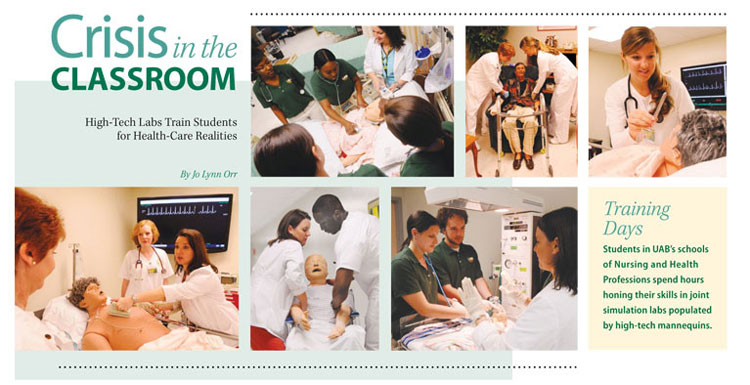
|
It’s the classic paradox of health-care education: No one wants to be treated by a trainee, yet the only way for today’s student to become tomorrow’s expert is through hands-on experience. UAB’s schools of Nursing and Health Professions have found a solution—a growing army of high-tech mannequins that can mimic everything from childbirth to a diabetic’s breath. The schools have pooled their resources to establish nine simulation labs that give students the chance to hone their skills in a challenging but controlled environment. Although the labs are not designed to be a substitute for actual clinical experience, “they do provide students with opportunities to learn a step-by-step approach to processing and managing medical crises and to critically analyze their response to these difficult situations,” says nursing researcher Jacqueline A. Moss, Ph.D. “Then, when they’re called upon to make decisions in the real world, they will be ready.” Using simulation labs as an assessment tool has led to improved quality and safety among students and health professionals, adds Moss. “Today’s practitioners are being called upon to continually demonstrate their professional competency to ensure patient safety and quality of care.” Not all simulation models are created equal. “Task trainers” mimic specific body parts—such as artificial arms or hips designed for practicing injections. Medium-fidelity mannequins can be controlled remotely and express the physiological responses of a real person. “In the maternal-child simulation lab, for instance, an instructor can change the baby mannequin’s heart rate and breath sounds,” Moss says. Story continues after video Model BehaviorThe ultimate patients are known as high-fidelity simulators. These are controlled via computer and specialized software, and they “can do just about everything you would expect a person to do in a specific medical situation,” Moss says. A “mother” mannequin in the maternal-child lab “talks and says things like, ‘the baby’s coming.’” The mother mannequin can also be programmed to simulate the baby traveling through the birth canal.” The overall goal of the labs is to make students’ training experiences seem as realistic as possible, says Penni Isla Watts, director of clinical simulation and training at the School of Nursing. “We have wounds that glue onto mannequins’ arms so that students can dress those wounds. We also simulate smells, such as the fruity breath that diabetics exhibit, and body waste. We want to give students the most realistic account of what they will encounter on the job.” A simulated apartment—complete with ‘parent’ and ‘child’ mannequins, overflowing ashtrays, kerosene lanterns, rotting food, and a (plastic) roach infestation—is designed to train future home health workers to recognize the diverse range of hazardous conditions they discover in their duties. Then there’s the “viewing classroom,” where students can watch their peers practice on high-fidelity mannequins in the emergency room simulation lab. Integrated digital audio-visual management systems broadcast the simulations to a large screen in the viewing classroom. The recorded audio and video is also synchronized with patient simulation logs and patient monitors to facilitate debriefing and evaluation of the simulated experiences, says Chad Epps, M.D., an assistant professor and director of simulation in the School of Health Professions nurse anesthesia program. “Students are sometimes not aware of their own behavior and the video debriefing establishes an irrefutable account of what occurred and fosters real behavioral change.” Training for TeamworkThe simulation labs have many possible uses beyond training nursing and health professions students, Epps notes. Facilitators are reaching out to other schools on campus to create model interprofessional teams. “With interprofessional training, we’re really concerned with how people interact,” Epps says. “Errors often occur when workers are not using a system correctly, or if they’re not able to communicate well with others. It’s difficult to teach these skills in a classroom, but the simulation lab can be very effective.” More Information |